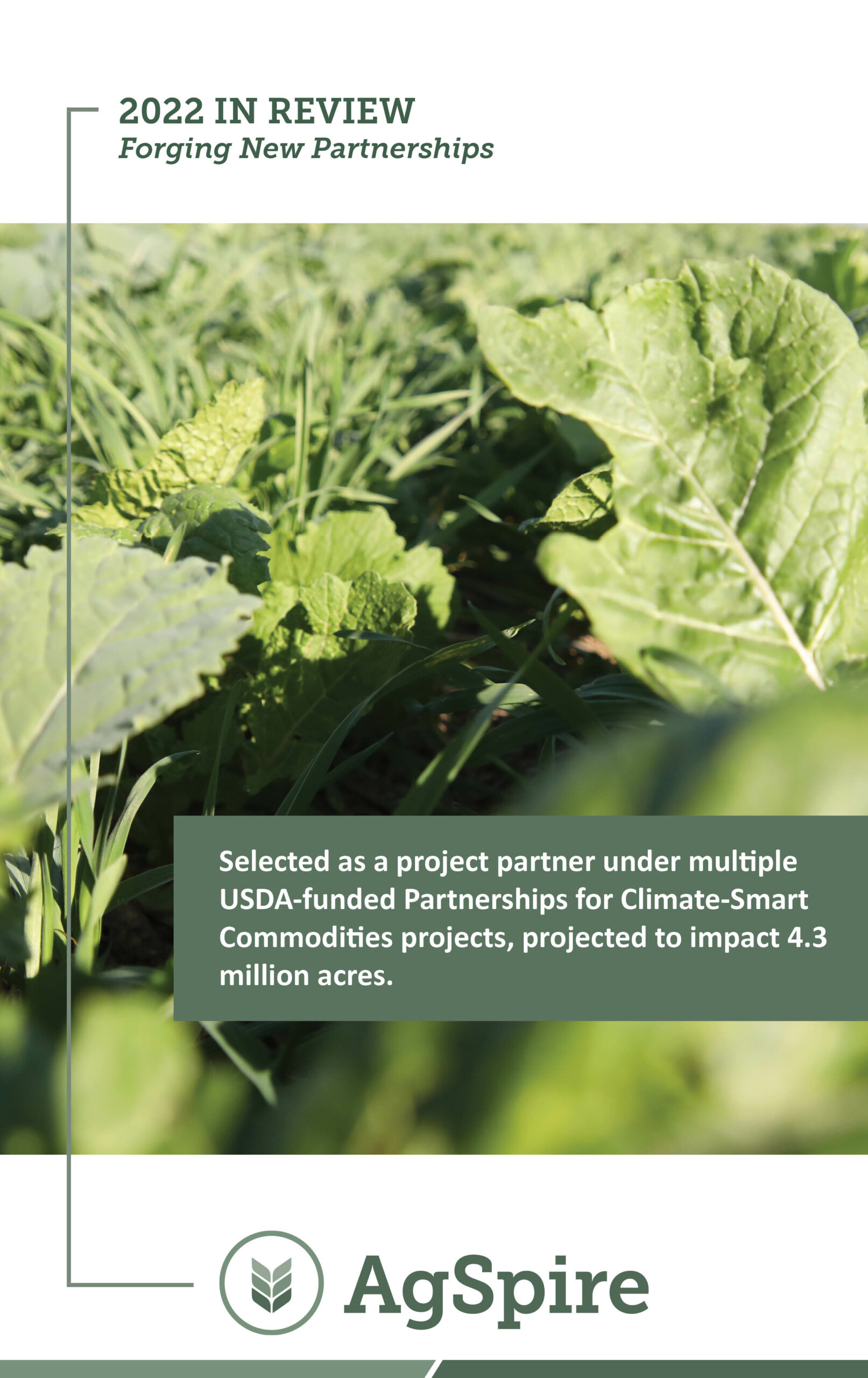
Above: Luke Hiebert on his farm, where he is using sustainable practices to increase access to forage for his cow/calf herd.
by Lura Roti for AgSpire
Fields of bright green rye stand out among the mostly brown early spring fieldscape on Luke Hiebert’s crop and livestock farm northeast of Huron, South Dakota.
“Traditionally, at this point in the season, nothing would be growing out in those fields. This is the reason I decided to plant rye,” said Hiebert, during an early April conversation. “It has been growing since last fall, and I like having a living root in the soil as long as possible. It helps with compaction, reduces erosion, increases water infiltration, builds organic matter and overall, improves soil health.”
There are additional benefits to this sustainable practice. Because Hiebert is enrolled in the Covering America Program through AgSpire’s SustainAg Network, he will receive a premium for the rye seed when he harvests it late summer.
The program will also cover the costs associated with the late season, multi-species cover crop he plans to plant on the same acres for his cattle and sheep to graze late fall. And, AgSpire connected him with one of their Technical Advisors to provide expert insights throughout the process.
“I and my wife, Briana are the third family trying to earn an income from this farm, so I need to look at value added opportunities because this farm is not large enough to support all of us,” explained the third-generation farmer who has been farming fulltime with his dad and uncle since he was 18.
For nearly a decade, Hiebert has been working to expand his cow/calf herd by increasing on-farm access to forage by implementing an intensive, daily grazing rotation. Extending the grazing season with a late season cover crop is yet another way for him to maximize the farm’s forage production.
For ag producers by ag producers
According to the recently released SustainAg Insights quarterly report, Hiebert is among 278 producers from across the U.S. who make up AgSpire’s newly formed SustainAg Network of farmers and ranchers interested in adopting sustainable land and livestock management practices through programs like Covering America. Since fully launching the Network in January 2024, AgSpire continues to expand its program offerings to farmers and ranchers, currently offering five programs, including a beef program in partnership with McDonald’s.
“AgSpire is focused on improving resiliency and sustainability across the entire agricultural supply chain,” explained Ryan Eichler, director of producer programs and a Lake Preston, South Dakota cattle producer. “Through The SustainAg Network, we connect producers with funding opportunities as well as resources to implement regenerative or sustainable practices.”
South Dakota crop and livestock producer Jared Knock came up with the idea for AgSpire after he observed a chronic disconnect between conservation-minded agriculture producers caring for land and livestock and funds allocated for regenerative agriculture practices by corporations and government entities.
“As a farmer who owns an ag retail business, I am closely connected to many farmers and ranchers trying to make changes on their land to increase soil health or livestock efficiency. At the same time, I was listening to what companies were saying about their desire to invest in farms and ranches in rural America for a positive environmental impact. But there was not a great way for the two groups to connect,” said Knock, who helped launch AgSpire in 2021.
“Our team has built an organization that connects sustainability-minded producers with those companies, developing and implementing programs around regenerative agricultural practices that benefit producers and improve our environment at the same time,” said Jared Knock, South Dakota Farmer and one of AgSpire’s founders.

Above: Jared Knock discusses regenerative agricultural practices with farmers in South Dakota, sharing how programs like Covering America can help them invest in their land and natural resources.
Regenerative agricultural practices like planting late-season cover crops.
Hiebert said knowing that there is financial and technical help planting a late season cover crop motivated him to join The SustainAg Network and enroll in the Covering America Program.
“I had been thinking about planting a late season cover crop, but I knew it would be more difficult to get it going and I was not ready to invest in the risk,” Hiebert said. “With SustainAg Network, I have financial assistance, and because I don’t have a lot of experience planting cover crops, I appreciate the fact I also have access to a Technical Advisor.”
The SustainAg Network offers voluntary, incentive-based grant and private-market sustainability programs, like the Covering America Program, that are designed with producers like Hiebert in mind, explained Eichler.
“We keep the agriculture producer at the forefront of everything we do because quite frankly, without producers, none of this can happen,” Eichler explained. “We use a highly customizable approach because each farm and ranch is very different. The last thing that we want to do is dictate practices or environmental programs if they don’t fit the producer’s land or livestock efficiency goals.”

Above: Ryan Eichler meets with a farmer in western Minnesota to discuss available programs in The SustainAg Network, and how they can benefit his land and business.
Eichler said The SustainAg Network’s team of advisors are essential to the process. “What sets us apart are our technical advisors,” Eichler said. “This team takes the time to meet with producers to understand their overall operation goals. And then they provide the support needed for a practice change to succeed.”
Once a producer selects and enrolls in a program, they connect with an advisor who helps them figure out the details and best practices for success in their growing conditions. Advisors also verify the practice and streamline incentive or premium payments.
“We are working on behalf of farmers and ranchers to help them increase revenue opportunities and overall resiliency,” Eichler said.